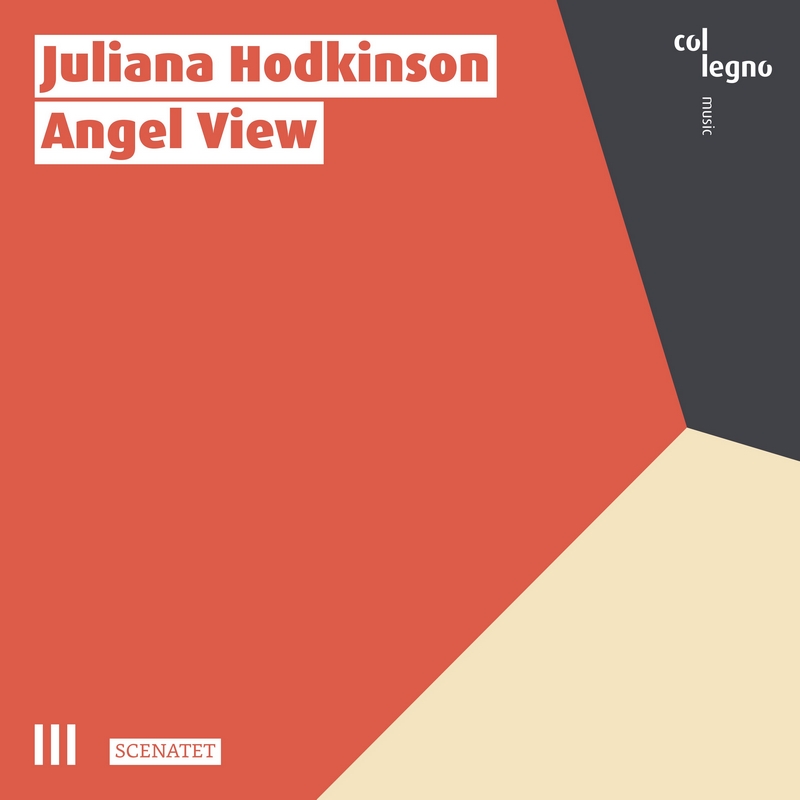
i’ve crossed paths with the music of Juliana Hodkinson on a few occasions over the last few years, and they’ve always been somewhat discombobulating experiences. My response each time has been ambivalent, primarily due to the way that Hodkinson seeks to harness – and, potentially, rely upon – physical and visual flamboyance as the focal point and locus of attention, without a correspondingly arresting or coherent longer-term narrative. So i was intrigued to explore Angel View, a new CD of Hodkinson’s music, and hear what she does in a purely sonic environment. No ambivalence this time, i’m happy to say: it’s a fascinating, engrossing and highly rewarding listen.
In addition to its lack of visuals, another aspect in which Angel View differs radically from my previous experiences of Hodkinson’s work is duration, with none of its 19 tracks lasting longer than five minutes; most are around a minute long with the shortest being a mere seven seconds. It’s a judgement call whether to regard them as being miniature, self-contained pieces or sections that together form a single, 35-minute work. Personally, i can never shake the impression of Angel View operating like a conveyor belt, carrying a continual stream of strange and fascinating sound objects in front of me. However they’re perceived, there’s a strong sense of connection and unity demonstrated across these pieces due to both the nature and the behaviour of the sounds used. They’re effectively electroacoustic, the members of Danish ensemble Scenatet being combined with subtle use of electronic and found sounds.
Though they lack a literal visual element, the music more than makes up for that by operating in a way that is overtly suggestive of the tangibility of physical objects: we’re not merely hearing sounds, but hearing the means by which those sounds are made constantly and vividly suggested. A recurring feature is the juxtaposition of rhythmic regularity and nebulous sound forms. The former usually manifest as percussive repetitions, not just conventional instruments but also bits of metal and glass, the latter of which often sounds broken (or in the process of being broken). An interesting quality of this is a kind of artless frivolity, less the product of performers with exquisitely-crafted instruments striving for accuracy and clarity than a bunch of friends having fun, mucking around with bits and bobs of scrap material they’ve found lying around. That’s the abiding sense in tracks such as ‘Crash 1873, boom 1990+’, ‘Mauerspechte’, ‘Trapped wings’, ‘Not for sale’ and ‘Betteln und Hausieren verboten!’, all short-lived bursts of rough and ready bangs, shakes and crashes. ‘Toys’ is similar in its mix of ricochets and granular electronics, sounding like a cross between animal sounds, jangling keys (or coins) and swishing friction, culminating in a gloriously exuberant outbreak of toy drums and cymbals.
The nebulous music, by contrast, is more indicative of care and subtlety. ‘Achtung. Stufe!’ features a nicely elusive sense of (active, not passive) drift, later accumulating a network of gentle electronic glitches and tics while the acoustic pitches slip-slide all over the place. Soft, dark chords in ‘As himself’ sit in a context created by snippets of ambient sound (seagulls, traffic, voices), creating a combined effect that’s indistinct and with a palpable sense of noir. ‘Large transactions’ picks up where it leaves off, with more insistent deep tones and an unsettling hint of violence in its insistent slapping accents. The most nebulous of all, essentially serving as a paradigm for Angel View as a whole, is ‘No. 113 Dining Room’, in which an almost inaudible background pitch cluster is practically obliterated by occasional foreground clatter, the whole time giving the impression that the piece is poised to unleash something at any moment, resolved in the seven seconds of total collapse captured in ‘Come Back all is forgiven’.
While most of the pieces are narratively ambiguous (and all the better for it), ‘A Storm is blowing’ takes a more direct approach. It pretty much does what it says on the tin, combining a variety of air and wind sounds with evocations of foghorns to create an intense, pseudo-weather formation. The 41 seconds of ‘Siren’ are similarly immediate, Hodkinson blending a variety of still and sliding pitches to create a beautiful tangled cluster that obliquely but recognisably alludes to its title. Closing track ‘Carousel’, too, lives up to its name through a mess of woodwind and chimes that sounds like a refracted funfair ride, one that becomes internalised before finally winding down, like a worn-out clockwork mechanism.
The music is at its most engaging when all these elements are intermingled in complex ways, in conjunction with tangible pitch and found sound elements that fall somewhere in between the aforementioned extremes of certainty and vagueness. ‘Travel souvenir’ places light instrumental notes alongside motes of digital and percussive glitter, in perhaps the most beguiling 90 seconds of the entire album. The highlight of Angel View is its longest track, ‘Kaiserpanorama’, an absorbing 5-minute narrative that passes through crackling ambience, poised instrumental tones, strange multilayered sounds that are simultaneously relaxed and robust, and an upward slide that sidesteps climax in favour of a weirdly lovely, gentle atmosphere of slowly undulating tones, placed within a real-world ambient environment that finally disappears, leaving them floating in an abstract void.
The joy of listening to Angel View comes partly from its imaginative array of sounds and their unpredictable deployment, but just as much from trying to parse their implied inner imperative, the unspoken narrative that gives rise to such a bizarre cavalcade of small-scale sonic wonders.
Recently released by Col Legno, Angel View is available on CD and download.

[…] The joy of listening to Angel View comes partly from its imaginative array of sounds and their unpredictable deployment, but just as much from trying to parse their implied inner imperative, the unspoken narrative that gives rise to such a bizarre cavalcade of small-scale sonic wonders.” [reviewed in May] […]